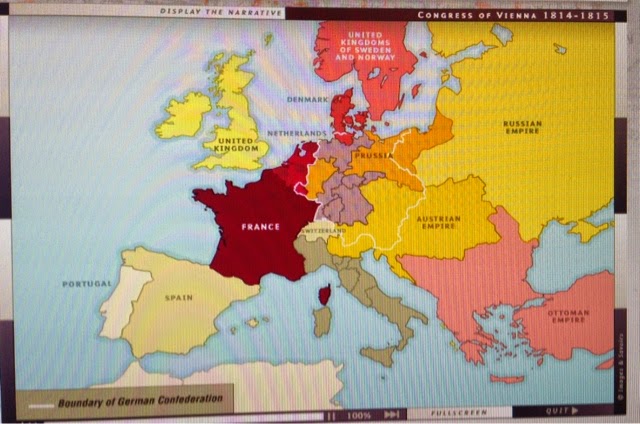For our second to last unit of the year we
learned about Buffalo Soldiers and Native Americans in the late 19th century,
and how their lives were impacted by the government at this time. Our set up
was the same for the last unit; we all read the same documents and watched the
same videos but took down notes according our assigned topic. My group’s topic
was ‘Key Terms’. We put all of our topics onto a collaborative google doc and
together used what we learned to come up with an essential question that could
be debated regarding the topic of Buffalo Soldiers and Native Americans. After
a lot of thinking, my class came up with the question; “Were federal policies
towards Native Americans and buffalo soldiers intentionally discriminatory or
well intentioned?” To answer this particular question we had to look beyond our
facts and terms that we discovered, and think about the meaning behind it all.
Buffalo Soldiers were African
Americans Cavalry Soldiers. African Americans have just recently fought for
their rights in the Civil War. The people and government then did not think
much of African Americans, mostly treated them like animals than people. But
now, in the late 19th century, African Americans were put into Cavalry Troops
to fight for their country. This was well intentioned gesture on the
government's part. They wanted African Americans to be able to fight and have a
job to do because most African Americans did not previously have one. Buffalo
Soldiers were given uniforms, duties, and were overall well respected. They
were very courageous and eager to fight. The Buffalo Soldiers served in the
Indian Wars and the Spanish American War. Although the legacy of the Buffalo
Soldiers was generally respected some people were intentionally discriminatory.
Just coming out of the Civil War feelings were still raw on the topic of
desegregation. Many fights broke out between the soldiers, citizens, and some
men in the forces, who did not want African Americans to have any type of
authority. The Buffalo Soldiers were also given the jobs that no other white
soldier would want to do. These actions were intentionally discriminatory.
| Group of Buffalo Soldiers source-http://tpwd.texas.gov/state-parks/programs/buffalo-soldiers/ |
Native Americans during this time lived
peacefully in the West without White interference. Native Americans and the
Federal Government originally had a tranquil relationship. However, in 1830
Andrew Jackson passed the Indian Removal Act which made many tribes including
the Cherokee, Creek, Chickasaw, and Seminole tribes, relocate to territory west
of the Mississippi River. This was said to be done because it gave benefits to
the Natives, not only the whites. However this was intentionally discriminatory
to the Natives. It was done so whites could continue to settle west and build
onto civilization. Once gold was found on the Natives land the Government
ordered the Soldiers to become violent to Natives who resisted them. Things
quickly became bloody. The technique of total war was used to wipe tribes. In
Helen Hunt Jackson: A Century of Dishonor (1881) it states, “These Indians
found themselves of a sudden surround by and caught up in the great influx of
gold-seeking settlers, as helpless creatures on a shore are caught up in a
tidal wave.” The government also removed the buffalo from Native lands, which
was their prime source of everything from food to clothing to tools. This was
all done intentionally by the Government that was run on their hunger for gold.
The government also wanted to help civilize the Native Americans, which
involved putting Native children into white-lead schools. This was done with
both a good intention and was also discriminatory. Government thought that they
were doing a good deed by giving the children an education and helping them
become one with society, when in reality these schools ultimately changed their
way of life for the worse. Government wanted to ‘Americanize” the Natives. This
was thought to be a good and moral idea on the Government's part at this time,
but ultimately was bad for the Natives. While these children were now educated,
these schools made the children lose the rich culture and tradition of the
Native Americans, which stumped the growth of Native Americans way of life for
future generations.
| Group of Native American Students at Indian Boarding Schools source- http://www.accmuseum.org/Boarding-School-Sports |
As you can see, the government's intentions were both discriminatory and well intentioned. For example, as stated before, the Government was well intentioned when they had African Americans become a part of the Cavalry units for the United States. This made these Soldiers, the Buffalo Soldiers, proud and excited to fight, even though there was still some discrimination. Sometimes The Government had well intentions, but it turned out to be the opposite, like the schools put in place for Native children. The intention was good on their part to give children education, but it actually made the kids leave all of their Native American culture behind and become “Americanized”. Other times the Government was directly discriminatory, especially with violently removing the Natives off their lands for the benefits of Whites. In conclusion, the government was both well intentioned and also discriminatory toward the Buffalo Soldiers and the Native Americans. I enjoyed the way this lesson was set up. I like being able to focus on one topic, like key terms, instead of struggling to capture everything from the sources. I wish my class would have done more of this type of learning earlier in the year.







